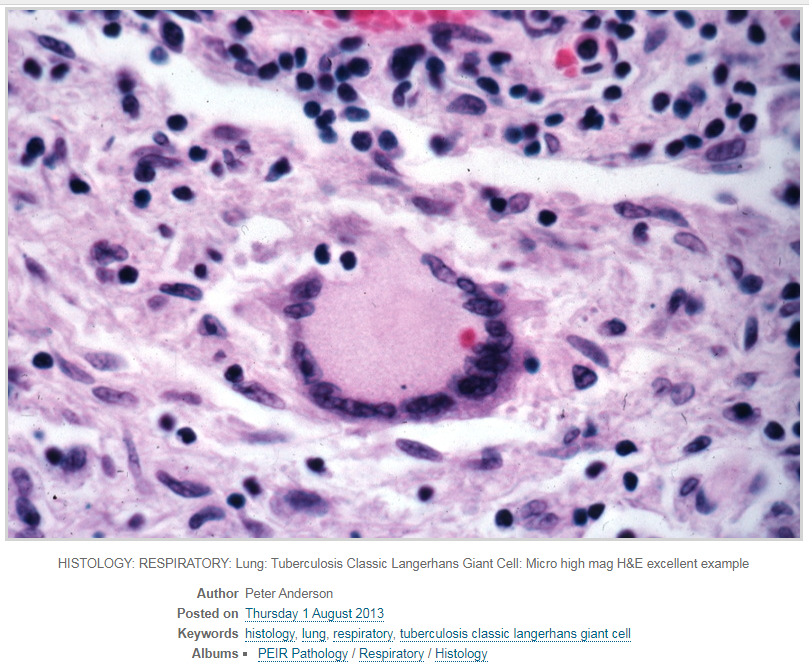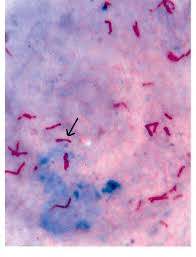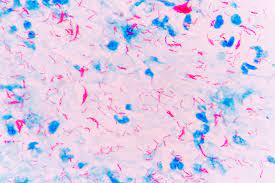Mycobacterium tuberculosis
Name the species of mycobacterium. Explain the morphology, pathogenesis and lab diagnosis of mycobacterium tuberculosis
Definition
Mycobacterium tuberculosis is a bacterium (pleural = bacteria) which causes the disease tuberculosis in the human beings
Mycobacterium bovis - in cows
Divides every 18-24 hours to multiply (veru slow) {the bacterium Escherichia coli - divides in 20 minutes}
It is a bacillus (means that it is rod shaped)
The rods are often seen wrapped together due to the fatty acids in the cell wall, and look like ropes
Requires oxygen to grow
Non motile
can withstand weak disinfectants
can survive in a dry state for weeks
the cell wall contains lipids making it resistant to desiccation and is a key virulence factor
Microscopy
Does not get stained by Gram's stain
Gets stained by acid fast stainslike Ziehl-Neelsen stain or fluorescent stains
M.tuberculosis is characterized in tissue by caseating granulomas containing Langhans giant cells,which have a "horseshoe"pattern of nuclei.
Culture
Can be grown in the lab
Remarkably slow growth rate, doubling roughly once per day
Mediums used : Liquids such asMiddlebrook 7H9or 7H12, egg based solid media such as Lowenstein-Jensen and solid agar-based such as Middlebrook 7H11 or 7H10
Visible colonies require several weeks to grow on agar plates
Distinguished from other mycobacteria by its production of catalase and niacin.
Other tests to confirm its identity : gene probes and MALDI-TOF
Pathophysiology
Humans are the only known reservoirsof M.tuberculosis
Spreads only through air droplets the infected persons (coughing, sneezing, sneezing,speaking or singing)
In the lungs it is phagocytosed by alveolar macrophages, but cannot be killed and digested by the macrophage. (evades macrophage-killing by neutralizing reactive nitrogen intermediates)
the bacteria multiply unchecked within the macrophage.
The bacteria is able to maintain a latent state for a prolonged period of time.
Protective granulomas are formed due to the production of cytokines
Granulotomatous lesions are important in both regulating the immune response and minimizing tissue damage.
Drug resistant strains of M. tuberculosis have resistance to more than one TB drug, due to mutations in their genes. In addition, pre-existing first-line TB drugs such as rifampicin and streptomycin have decreased efficiency in clearing intracellular M. tuberculosis due not being able to effectively penetrate the macrophage niche
Symptoms
coughing that lasts for more than three weeks
hemoptysis
chest pain when breathing or coughing
weight loss
fatigue
fever
night sweats
chills,
loss of appetite.
M. tuberculosis also has the potential of spreading to other parts of the body.
This can cause blood in urine if the kidneys are affected, and back pain if the spine is affected.[31]
Lab Tests to diagnose TB
Mantoux test - Induration more than 10 - 20 mm is positive - Skin test
PCR test (Polymerase Chain Reaction Test) - Blood test
Sputum examined by microscopy - to detect the pink rod like bacilli
Tissue Biopsy - Langhan's Giant cells foun in a granuloma in the tissue
Bacterial Culture and sensitivity
Strain variation
Typing of strains is useful in the investigation of tuberculosis outbreaks; M. tuberculosis strains are typed by variable numbers of tandem repeats (VNTR), discrimination between strains. This method makes use of the presence of repeated DNA sequences within the M. tuberculosis genome.
Antibiotic resistance in M. tuberculosis typically occurs due to either the accumulation of mutations in the genes targeted by the antibiotic or a change in titration of the drug. M. tuberculosis is considered to be multidrug-resistant (MDR TB) if it has developed drug resistance to both rifampicin and isoniazid, which are the most important antibiotics used in treatment. Additionally, extensively drug-resistant M. tuberculosis (XDR TB) is characterized by resistance to both isoniazid and rifampin, plus any fluoroquinolone and at least one of three injectable second-line drugs (i.e., amikacin, kanamycin, or capreomycin).
A much cited study reported that M. tuberculosis has co-evolved with human populations, and that the most recent common ancestor of the M. tuberculosis complex evolved between 40,000 and 70,000 years ago.
Vaccine
The BCG vaccine (bacille Calmette-Guerin), is derived from M. bovis.
The BCG, according to an article of the Kyodo News (April 14, 2020) titled "Tuberculosis vaccine drawing attention in fight against coronavirus" indicates a possible correlation between BCG vaccination, and better immune response to the COVID-19.
P.S.
A bacterium which is shaped is called a coccus (Pleural is cocci)
A bacteriumwhich is Rod shaped is called a bacillus (Pleural bacilli)
Acid fast stain means a stain which holds on strongly to the bacteria even if wahed by acid.
* * * * * * * *





